Cowrie
Cowry money is a historical form of simple money (primitive money) that was widespread in Africa, East and South Asia and the South Seas as a pre-coinage means of payment or money in kind (commodity money made from natural objects) and is still traditionally and ritually used in some places today. Consisting of or made from the shells of cowries, cowry money was the most widespread shell or snail shell money by space and time (also known as mollusk money in coinage). The cowries were usually strung on bast threads and traded as money strings, and for even larger amounts there were basket-shaped hollow measures in some areas. Cowries circulated in parts of Africa, India, Afghanistan, Southeast Asia, China, and many islands of Melanesia.
In Africa it was almost always and exclusively barter or trade money. Kauri money was the first universal money and played a major role in inter-regional trade. Kauri money existed before metal coins and in some cases it was in use parallel to metal coins. Since transportation and trade used to be very easy, cowries became more valuable the further inland they were transported. The snail shells were collected mainly in the Maldives and around the Gulf of Thailand.
The small, egg-shaped, very stable cowrie shells with their brightly colored shells with a shiny enamel coating were used from about 2000 BC, still in the Bronze Age, until the late 19th century. They circulated as counterfeit-proof international "currency" halfway around the globe. Strictly speaking, cowry money was not money in the sense of currency, because there was no state supervision and no banking system for it; cowry money, however, served as a store of value. Kauri money was first used in South Asia and Southeast Asia, China and India, and later in East Africa, Central Africa and tropical West Africa, as well as in the South Seas. In many regions of Asia and Africa the cowrie was both a commodity and a means of payment.
In the pre-metallic monetary system, cowry money stood at the border between money and non-money, since cowries were also used as jewellery. Cowry money was a zoogenic currency (made of animal components), like fur money or leather money.
After its heyday in China, this pre-coinage means of payment was also used in India and on the islands of the Indian Ocean as coins, from where merchants brought it to Africa. Because of its relatively low value, cowry money was particularly useful as small change. In South Asia its use ended in the 19th century, in West Africa at the beginning of the 20th century.
A single cowrie shell itself had little value, which is another reason why large quantities of it were used as currency. In colonial Germany this means of payment was also called "Negro money". Kauri money was a popular subject in the accounts of explorers and travellers.
The size and weight of the traded cowrie species are quite uniform. The average weight of a cowrie ranges from 0.8 to 3.5 grams. The market value of the cowrie was based on mutual agreement and was independent of its size - each cowrie had the same monetary value. The exchange rate of cowry money to money coins, which were often in parallel circulation, fluctuated according to supply and demand. In most cases cowry money was not legal tender, because there was no legal right to accept cowries as a means of payment.
.webm.jpg)
Play media file Video: The first means of payment (including cowry money)
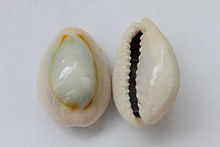
Ring cowrie from above and below
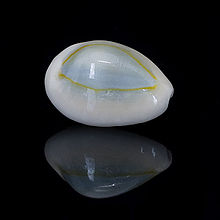
Ring cowrie (Monetaria annulus)
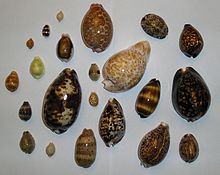
shells of various cowries, of which 200 are known so far
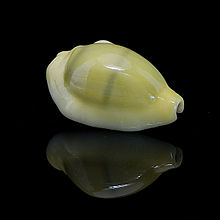
Money cowrie (Monetaria moneta)
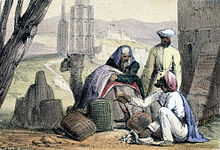
Arab traders with cowries used as money (print from 1845)
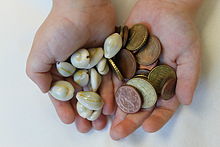
Eleven shells of the ring cowry snail and euro cent coins - such snails served as cowry money, mainly as small change
Names
The Portuguese word buzio (from Latin bucina) also naturalized in adapted form in the other European languages spoken on the African west coast. In English, buzio was adapted to booge, probably influenced by the French bouge. Other forms were buji and bousie. From 1700, the English word cowrie gradually took the place of booge.
The name of the cowry is derived from the Indian Hindi word kaurī and was adopted into English as cowrie, Dutch kowers, coris, bouge, Spanish bucio, cauri or buzio, French porcelaine. Among the Arabs they were called kauri, among the Sudanese Kanuri kungena, and among the Nigerian Hausa kerdi.
Porcelain
European traders called the cowries porcelains ("little pigs"). The name "porcelain" also goes back to the Italian name for the cowries, which are also called porcelain snails. After Marco Polo (allegedly) brought the first Chinese porcelain to Europe, it was believed in 15th century Italy that Chinese porcelain was made from the crushed yellowish-white shells of cowries, called porcellana in Italian. This goes back to porcellano (actually "little pig", from Latin porcellus) for the external sexual organ of women, as the shape of the snail shell is reminiscent of it (compare clams: concha veneris).
Source
Kauri money originated on the islands of the Maldives in the Indian Ocean; from there it spread throughout Asia, and later to Africa and various South Sea islands. It gained importance especially in ancient China, where it was the recognized reserve currency from 1500 B.C. to 200 A.D. (see Early Chinese Currency).
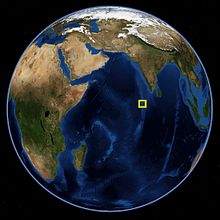
Location of the Maldives in the Indian Ocean
Search within the encyclopedia